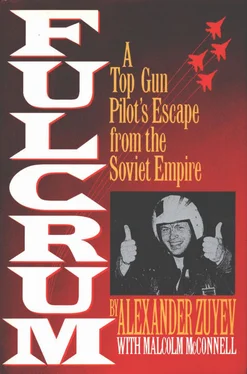Then the number one engine roared alive. I slid both throttles up the rail and felt the plane surge ahead. In a desperate two-handed motion, I cut the throttles back, tripped the nosewheel-steering button on the inner throttle knob, and managed to squeeze the brake lever correctly to slow my momentum.
The fighter lurched into a hard right turn and I tapped left rudder with my boot to align the nose on the centerline of the taxi ramp. I was free. In the cockpit mirror I saw the heavy generator cart tumbling end over end, sparking wildly in the 22,500-pound blast of combined thrust.
I was finally moving, but everything felt wrong. The engines seemed so loud because I wore no helmet and the canopy still gaped open. Something hard and sharp jabbed at the base of my spine. It was the rectangular aluminum warning plate connected by elastic lines to the multiple safety pins blocking the arm restraints and igniter system of the K-36D ejection seat. The harness straps and buckles were stiff and jumbled behind my shoulders. Although I could not see the plate, its red warning label, “Remove Before Flight,” seemed to mock me. The pain from the unbuckled ejection harness was more than physical. If the fighter lost an engine on afterburner takeoff, or I was shot down before I could properly strap in and remove those safety pins, the system would be useless. I would die.
Away to the right, I saw four men moving near the front door of the duty-alert building. One of them had his arm raised, pointing toward me. He might have held a pistol, but it was too far to distinguish it. It was time to close the canopy. My own pistol jammed between my thighs would no longer be of much use. The Plexiglas dome snapped down smoothly, dampening the throaty roar of the engines. I heard the hiss as the pressure seal closed tightly.
I was taxiing so fast that the plane swayed violently on the rough concrete blocks of the ramp. But I still had to try to align the gyroscopes of my altitude direction indicator (ADI). Without an artificial horizon, fast low-altitude flight would be even more hazardous. As the cockpit wobbled, the aircraft symbol on the ADI ball swung wildly, and the synchronize button flashed its red warning that the gyro platform had not yet aligned. But I certainly was not going to stop here on the taxi ramp and patiently wait for the system to warm up. I stabbed the button with my left thumb to recage the gyros, freezing the ADI aircraft symbol in a drunken thirty-degree left bank, in a slight nose-down pitch. So be it. This was not a training exercise.
But whichever pilot — Petrukhin or Gromov — followed me in the one undamaged alert fighter would have to wait for his gyro platform to stabilize. And his ground crew would also take the time to pull all the canvas sheaths and apron covers from his avionics probes and missiles. All that would take at least five minutes. Add a minute for the two undrugged pilots to dash down to the apron, followed by their groggy mechanics. Add another minute for general confusion.
If I took off now, I would have a seven-minute lead on my pursuers. At transonic speed, 630 knots, the direct route across the Black Sea to Turkish airspace would take about ten minutes. Necessity had just intervened to select Plan Two. Whatever Soviet naval contingent was out there waiting for me on this clear spring morning, I would have to face them. Missile frigates were the lesser of many evils. I certainly could not engage a pilot like Petrukhin, or even Gromov, with just my cannon against their Archer and Alamo missiles. Yet I had to accept the aerodynamic drag of my own full set of missiles on the underwing pylons, even though they were useless still wrapped in their canvas ground covers.
The end of Runway 09 was coming up fast. Just before I braked again, I checked the PTO panel to verify that the main weapon circuit breaker was snapped on. Even though I was wounded and the duty-alert section had obviously been alarmed, I still intended to attack the MiG-29s parked behind me on the angled taxi ramp.
I remembered to trip the takeoff flap button on the left console, dumping twenty degrees leading-edge slats and twenty-five-degree flaps. The comforting yellow indicator lights winked on the panel ahead of my left knee. The plane was bouncing now, gathering momentum, even though I had cut the throttles to idle. I was aware that the canvas canopy cover above my head was peeling back in the slipstream like the skin of a rotten fruit.
My eyes shot to the engine gauges on the right side of the panel. Thrust was steady. RPM matched on both engines. And the tail pipe temperatures were in the normal sector. Stable engines. Flaps, slats. That was it. Not much of a takeoff checklist with this drunken ADI, a dead navigation display, and no airspeed indicator. But it would have to do.
I tapped the left rudder and sliced into a hard rocking left turn without braking again, a dangerous maneuver with that full belly tank. The plane actually seemed to bank, swinging here on the end of the runway. I scanned the entire length of the runway, no vehicles blocking the long concrete ribbon. As soon as the nose swung onto the centerline, I released the throttle spring stops and jammed the knobs all the way forward to maximum afterburner.
The sudden thrust kicked me back into the seat, forcing my injured shoulder against the jumbled straps. But that was the best pain I had ever felt. Raw jet fuel was streaming into the twin exhaust streams to ignite in the double-walled chambers of the afterburners. On the master board at the upper right corner of the instrument panel, the twin green symbols Ф lit up, forsazh. I had maximum afterburners lit. Nothing on the ground could stop me now.
The fighter bore smoothly down the centerline, gathering speed with every second. Wearing no helmet, I was acutely aware of the burners’ thunderous rumble behind me. Instinctively my eye went to the airspeed indicator, and for a moment I was shocked to see the needle stationary. On a thousand takeoffs I had waited patiently for a needle just like this to swing smoothly up to 96 knots. But with the Pitot tubes still covered, the instrument was dead. I had to judge my rotation speed by other means. The grassy margins of the runway spun past in a blur. I had been on the takeoff roll five seconds. Holding the stick in my left hand felt weird. But at least with the throttles locked, I had this hand free.
Then, at the right corner of my panel, I saw the engine inlet indicators switch from the upper louvers of the shark gills to the main inlets. This meant my airspeed had just passed 107 knots. But I held the nose down two seconds longer. I needed adequate airspeed with a full tank and these external weapons.
I must have rotated at more than 150 knots because there was no hint of hesitation. The nose swung up smoothly as if on a hydraulic piston and I was climbing steeply into the hot eye of the rising sun. The instrument panel clock said exactly 0524 hours.
I switched hands clumsily and groped for the gear lever, then retracted flaps and slats. My right hand was becoming so numb on the stick that I was afraid of losing control. I kept the throttles on maximum afterburner and grabbed the stick again with my left hand. I certainly did not want to pitch up too steeply and stall. And my climb angle was much too high. In order to execute a proper strafing run, I had to match the angle of my climb with the desired dive slope of the cannon run, thirty degrees. I pushed the stick gently forward to bring down the nose.
I would have to drop the belly tank in order to fire the cannon. But I hated to waste any of that precious fuel. So I waited as I climbed. My radar altimeter was working, but was only accurate up to 1,500 feet. Without a barometric altimeter, I had to judge my altitude by scanning the terrain for visual cues and taking angular projections on reference points below. The most important of these landmarks was the red-roofed village that lay past the road beyond the air base perimeter.
Читать дальше










